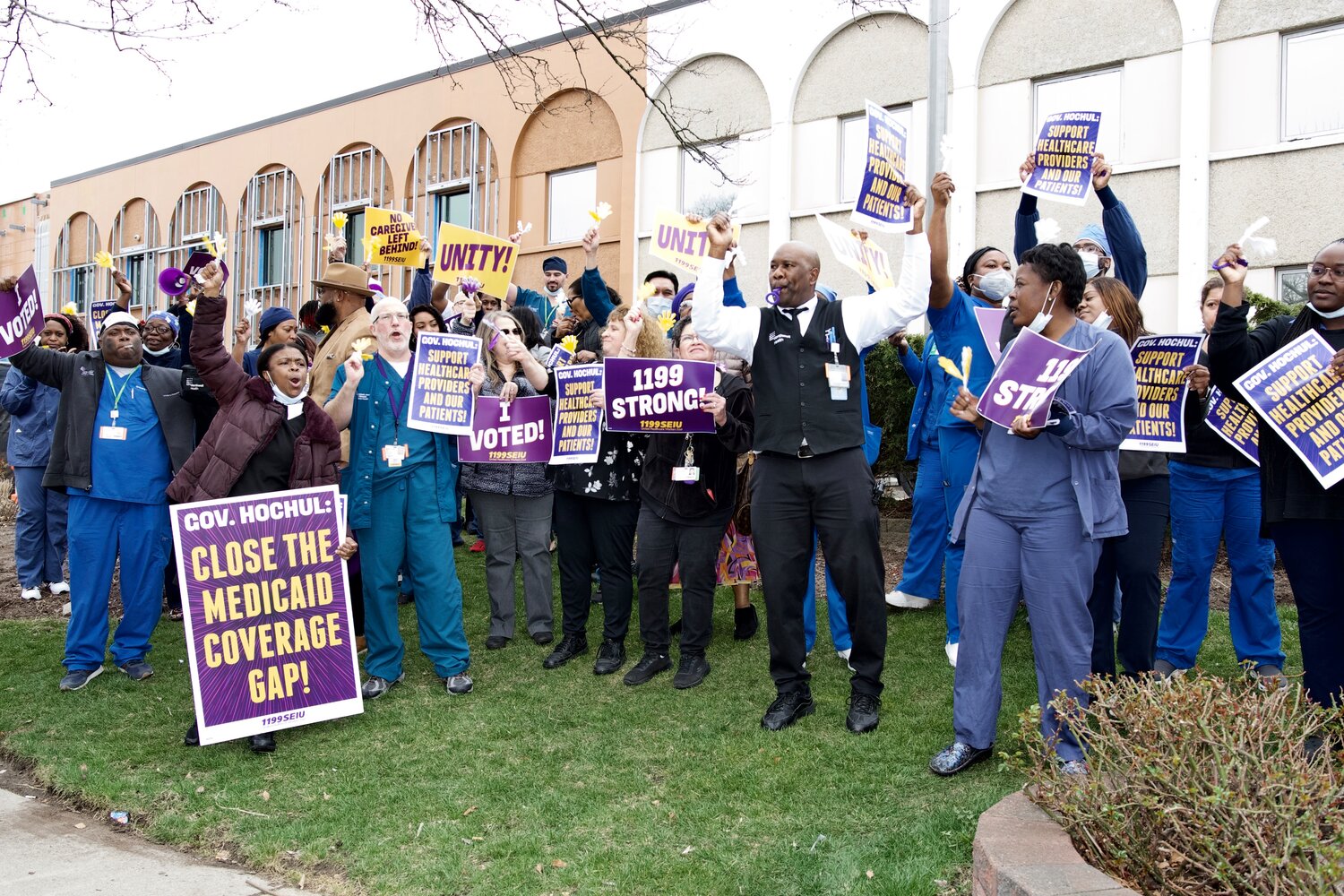Here's why Long Island Jewish Valley Stream health care workers rallied against Hochul’s budget
Editor's note: state lawmakers approved a fourth budget extension deadline on April 20 to keep the government running through April 24.
Dozens of unionized Long Island Jewish Valley Stream health care workers gathered outside the hospital during their lunch break on April 5 to call on Gov. Kathy Hochul to rectify what many see as health care funding shortfalls in the state’s budget and urge lawmakers in Albany to close the Medicaid coverage gap.
Organizers from 1199SEIU United Healthcare Workers East led the protest. One spoke through a bullhorn, and led the crowd in chants including, “Governor Hochul: Close the gap!” Drivers passing the hospital on Franklin Avenue honked in support of the gathering.
The demonstration, which began at noon, was one of a smattering of protests held at hospitals across the state in recent weeks to pressure the governor in the final stretch of budget negotiations.
One of the biggest issues at play in this budget season is how much lawmakers will hike the Medicaid reimbursement rates for nursing homes and hospitals, institutions that haven’t seen an increase in those rates since 2007. The demonstrators said that no less than a 20 percent increase for nursing homes and 10 percent for hospitals is needed to financially buttress facilities that have been battered by soaring health care costs and staffing shortages, to fairly compensate their employees.
Administrators and industry leaders say that without a larger increase than the 5 percent pitched in Hochul’s executive budget, many health care facilities — particularly nursing homes — could face further financial difficulties, forcing them to reduce the number of beds, cut staff or go under.
Also included on their list of demands is $2.5 billion more in health care investment atop Hochul’s proposed $20 billion multi-year investment plan, and a reversal of course on a $700 million cut to safety-net hospitals, which provide care regardless of patients’ insurance status or their ability to pay.
“(During the pandemic) we were treated as health care heroes. Today we’re not being treated like that,” said Claire Leon, a medical assistant who has worked at LIJ Valley Stream for 15 years and was bewildered by the governor’s health care spending plan. “Why is the governor refusing to give us the funds that we need for hospitals? Why is the medical staff suffering work shortages? Why are the nursing home staff underpaid? Why is she taking money that we health care workers deserve?”
Others, like hospital nutrition aid Ian Powell, said they worried about how this perceived underinvestment in health care would affect health care workers elsewhere.
“I don’t want myself or any other coworker across the health care industry to be out of a job because of (the governor’s) spending cuts,” Powell said. “We don’t want any small facilities to be cut. With the cost of living so high, we need raises, not a cut in our benefits.”
“After all that we’d been through during the pandemic, the governor shouldn’t think twice about raising the reimbursement rates,” radiographer Thomas Gough said. “How can she be holding back on funding when we were here day after day during Covid-19, reusing N95 respirator masks that we spent money on and weren’t reimbursed for?”
Hospital executives would not comment on the protest.
“Before Covid, the investment in safety-net hospitals was very low, as well as the investment in lower-wage earners in long-term care facilities, like home health aides,” Martine Hackett, an associate professor of public health at Hofstra University, said. “Without a high level of investment in these health care workers, who are already overworked and underpaid, we’re going to see an erosion in the care that is available for everyone.”
Even as union leaders say more investment is warranted given the state’s comfortable $8.7 billion budget surplus, however, fiscal hawks are urging lawmakers to show financial restraint amid a predicted decline in state revenue in the coming years. And that includes keeping a tight lid on health care spending, which already takes the biggest bite out of the budget each year.
Other critics of Medicaid reimbursement rate hikes have also cast doubt on their effectiveness in helping hospitals and nursing homes retain staff, especially in areas of the state where Medicaid isn’t a dominant source of health coverage.
Still other experts, like Hackett, are worried about where an increase in funding would ultimately end up. “Part of the concern is that the money from the increased Medicaid reimbursement rates will go mostly to the hospital administration and health systems,” she said. “And the people who are actually doing the care and delivering the service are not going to be compensated in a similar way.”
Representatives from the governor’s office could not be reached for comment at press time. Nevertheless, leaders in the State Legislature were standing behind a more robust health care investment than the one laid out by Hochul as budget talks dragged on past the April 1 deadline. As of press time, the spending plan was expected to be finalized on Thursday.
Have an opinion on this article? Send an email to jlasso@liherald.com.

 50.0°,
Overcast
50.0°,
Overcast 




